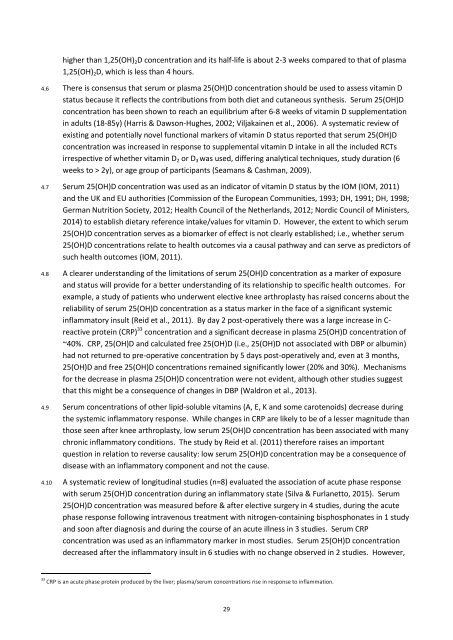Vitamin D and Health
SACN_Vitamin_D_and_Health_report
SACN_Vitamin_D_and_Health_report
You also want an ePaper? Increase the reach of your titles
YUMPU automatically turns print PDFs into web optimized ePapers that Google loves.
higher than 1,25(OH) 2 D concentration <strong>and</strong> its half-life is about 2-3 weeks compared to that of plasma<br />
1,25(OH) 2 D, which is less than 4 hours.<br />
4.6 There is consensus that serum or plasma 25(OH)D concentration should be used to assess vitamin D<br />
status because it reflects the contributions from both diet <strong>and</strong> cutaneous synthesis. Serum 25(OH)D<br />
concentration has been shown to reach an equilibrium after 6-8 weeks of vitamin D supplementation<br />
in adults (18-85y) (Harris & Dawson-Hughes, 2002; Viljakainen et al., 2006). A systematic review of<br />
existing <strong>and</strong> potentially novel functional markers of vitamin D status reported that serum 25(OH)D<br />
concentration was increased in response to supplemental vitamin D intake in all the included RCTs<br />
irrespective of whether vitamin D 2 or D 3 was used, differing analytical techniques, study duration (6<br />
weeks to > 2y), or age group of participants (Seamans & Cashman, 2009).<br />
4.7 Serum 25(OH)D concentration was used as an indicator of vitamin D status by the IOM (IOM, 2011)<br />
<strong>and</strong> the UK <strong>and</strong> EU authorities (Commission of the European Communities, 1993; DH, 1991; DH, 1998;<br />
German Nutrition Society, 2012; <strong>Health</strong> Council of the Netherl<strong>and</strong>s, 2012; Nordic Council of Ministers,<br />
2014) to establish dietary reference intake/values for vitamin D. However, the extent to which serum<br />
25(OH)D concentration serves as a biomarker of effect is not clearly established; i.e., whether serum<br />
25(OH)D concentrations relate to health outcomes via a causal pathway <strong>and</strong> can serve as predictors of<br />
such health outcomes (IOM, 2011).<br />
4.8 A clearer underst<strong>and</strong>ing of the limitations of serum 25(OH)D concentration as a marker of exposure<br />
<strong>and</strong> status will provide for a better underst<strong>and</strong>ing of its relationship to specific health outcomes. For<br />
example, a study of patients who underwent elective knee arthroplasty has raised concerns about the<br />
reliability of serum 25(OH)D concentration as a status marker in the face of a significant systemic<br />
inflammatory insult (Reid et al., 2011). By day 2 post-operatively there was a large increase in C-<br />
reactive protein (CRP) 33 concentration <strong>and</strong> a significant decrease in plasma 25(OH)D concentration of<br />
~40%. CRP, 25(OH)D <strong>and</strong> calculated free 25(OH)D (i.e., 25(OH)D not associated with DBP or albumin)<br />
had not returned to pre-operative concentration by 5 days post-operatively <strong>and</strong>, even at 3 months,<br />
25(OH)D <strong>and</strong> free 25(OH)D concentrations remained significantly lower (20% <strong>and</strong> 30%). Mechanisms<br />
for the decrease in plasma 25(OH)D concentration were not evident, although other studies suggest<br />
that this might be a consequence of changes in DBP (Waldron et al., 2013).<br />
4.9 Serum concentrations of other lipid-soluble vitamins (A, E, K <strong>and</strong> some carotenoids) decrease during<br />
the systemic inflammatory response. While changes in CRP are likely to be of a lesser magnitude than<br />
those seen after knee arthroplasty, low serum 25(OH)D concentration has been associated with many<br />
chronic inflammatory conditions. The study by Reid et al. (2011) therefore raises an important<br />
question in relation to reverse causality: low serum 25(OH)D concentration may be a consequence of<br />
disease with an inflammatory component <strong>and</strong> not the cause.<br />
4.10 A systematic review of longitudinal studies (n=8) evaluated the association of acute phase response<br />
with serum 25(OH)D concentration during an inflammatory state (Silva & Furlanetto, 2015). Serum<br />
25(OH)D concentration was measured before & after elective surgery in 4 studies, during the acute<br />
phase response following intravenous treatment with nitrogen-containing bisphosphonates in 1 study<br />
<strong>and</strong> soon after diagnosis <strong>and</strong> during the course of an acute illness in 3 studies. Serum CRP<br />
concentration was used as an inflammatory marker in most studies. Serum 25(OH)D concentration<br />
decreased after the inflammatory insult in 6 studies with no change observed in 2 studies. However,<br />
33 CRP is an acute phase protein produced by the liver; plasma/serum concentrations rise in response to inflammation.<br />
29


